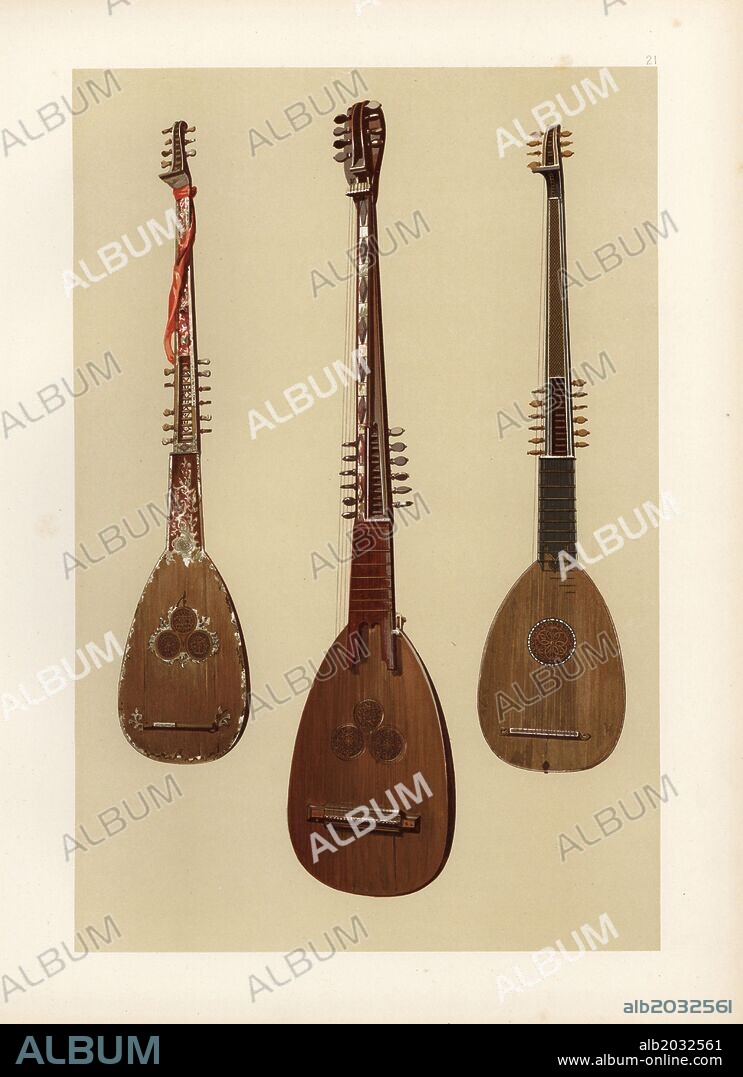alb2032561
Three chitarroni (theorbo or bass lute). Venetian chitarrone with inlaid mother of pearl (left), Venetian chitarrone from 1608 (centre), and one exhibited in 1885 by Edward Joseph of Bond Street with six pairs of unisons and seven diapasons (right). Chromolithograph from an illustration by William Gibb from A.J. Hipkins' "Musical Instruments, Historic, Rare and Unique," Adam and Charles Black, Edinburgh, 1888. Alfred James Hipkins (1826-1903) was an English musicologist who specialized in the history of the pianoforte and other instruments. William Gibb was a master illustrator and chromolithographer and illustrated "The Royal House of Stuart" (1890), "Naval and Military Trophies" (1896), and others.

|
Añadir a otro lightbox |
|
Añadir a otro lightbox |



¿Ya tienes cuenta? Iniciar sesión
¿No tienes cuenta? Regístrate
Compra esta imagen.
Selecciona el uso:

Descripción:
Ver traducción automática
Three chitarroni (theorbo or bass lute). Venetian chitarrone with inlaid mother of pearl (left), Venetian chitarrone from 1608 (centre), and one exhibited in 1885 by Edward Joseph of Bond Street with six pairs of unisons and seven diapasons (right). Chromolithograph from an illustration by William Gibb from A.J. Hipkins' "Musical Instruments, Historic, Rare and Unique," Adam and Charles Black, Edinburgh, 1888. Alfred James Hipkins (1826-1903) was an English musicologist who specialized in the history of the pianoforte and other instruments. William Gibb was a master illustrator and chromolithographer and illustrated "The Royal House of Stuart" (1890), "Naval and Military Trophies" (1896), and others.
Crédito:
Album / Florilegius
Autorizaciones:
Modelo: No - Propiedad: No
¿Preguntas relacionadas con los derechos?
¿Preguntas relacionadas con los derechos?
Tamaño imagen:
4232 x 5829 px | 70.6 MB
Tamaño impresión:
35.8 x 49.4 cm | 14.1 x 19.4 in (300 dpi)
Palabras clave:
1888 • ALFRED • ARTISTA • BAJO • CANCION • CHITARRONE • COLOR • COLORIDO • CROMOLITOGRAFIA • DIAPASON • EDIMBURGO • GUITARRA • HISTORIA • HISTORICAL • HISTORICO • ILUSTRACION • ILUSTRADOR • INSTRUMENT • INSTRUMENTO • JAMES • LAUD (INSTRUMENTO MUSICAL) • LITOGRAFIA • MUSIC • MÚSICA • MUSICAL • MUSICOGRAFO • PIANOFORTE • RARAS • ROMANA • ROMANO • ROMANOS • UNICA • VENECIANO • WILLIAM
 Pinterest
Pinterest Twitter
Twitter Facebook
Facebook Copiar enlace
Copiar enlace Email
Email
